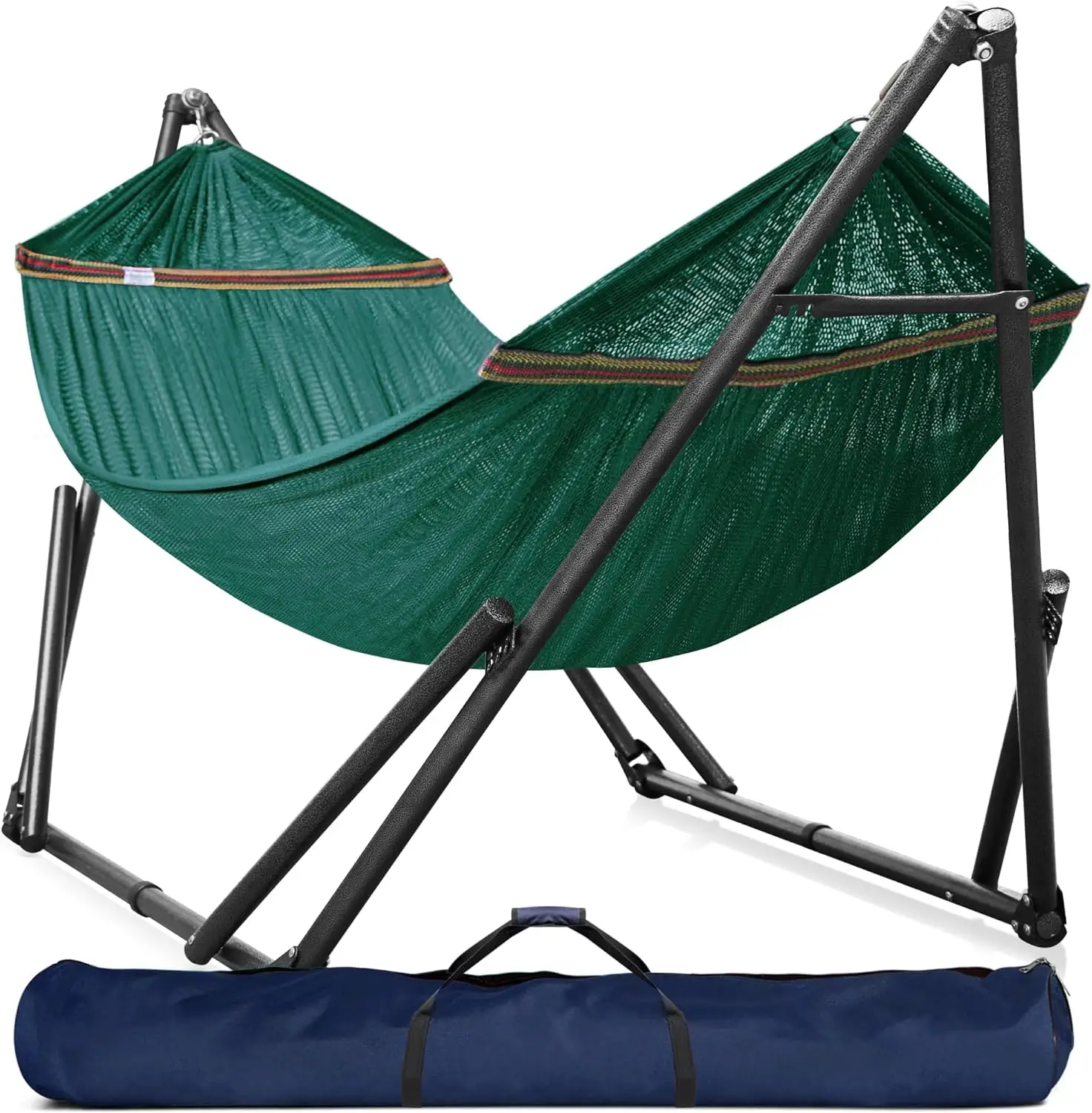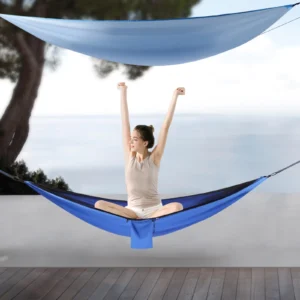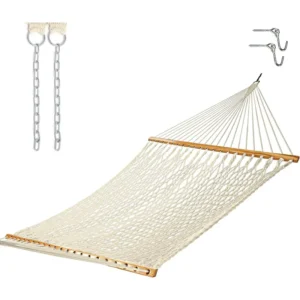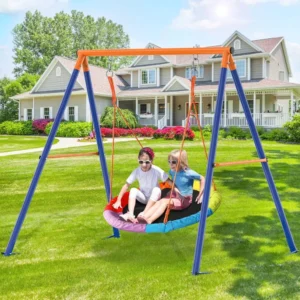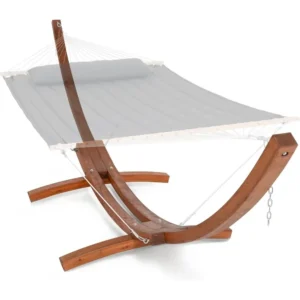Why Hammock Weight Limits Matter: Beyond the Numbers
When shopping for a hammock, you’ll always see a weight capacity listed. But this number means much more than just whether the hammock will hold you. The weight capacity represents the maximum safe load a hammock can reliably support during normal use—not the point at which it will suddenly snap.
Understanding these limits is crucial for several reasons:
- Safety first: Hammocks that fail can cause falls resulting in injuries ranging from minor bruises to more serious harm
- Long-term durability: Even if a hammock doesn’t break immediately when overloaded, exceeding its weight capacity regularly causes micro-damage to fibers, stitching, and hardware
- Comfort: A hammock near its weight limit may sag excessively or lose its ergonomic benefits
- Warranty protection: Using a hammock beyond its rated capacity often voids manufacturer warranties
What actually happens when weight limits are exceeded? The fabric stretches more than designed, stitching begins to pull apart at stress points, and suspension components experience forces they weren’t built to handle. Over time, this cumulative stress weakens the entire system.
The engineering behind hammock weight capacity guidelines involves careful calculation of material strength, strategic reinforcement at stress points, and comprehensive testing. For users requiring more substantial support, heavy-duty hammock sets offer specially designed options that don’t compromise on safety or comfort.
The Science of Strength: How Hammocks Support Weight
Material Science: Foundation of Load-Bearing Capacity
The materials used in hammock construction form the foundation of its weight capacity. Different fibers offer varying levels of strength, durability, and performance characteristics:
Nylon is popular in camping and travel hammocks due to its excellent strength-to-weight ratio. Manufacturers often specify a “denier” rating—a measure of fiber thickness where higher numbers indicate stronger materials:
– 70D (lightweight) typically supports 300-400 lbs
– 210D (medium weight) supports 400-500 lbs
– 410D+ (heavy duty) can support 500+ lbs
Polyester offers excellent load-bearing capacity with less stretch than nylon, maintaining shape better under load. It also provides superior UV resistance, making it ideal for outdoor use.
Cotton provides comfort but offers less tensile strength than synthetic materials. Cotton rope hammocks distribute weight through multiple connection points, while fabric versions require tighter weaves for comparable strength.
Specialty fabrics include ripstop nylon (reinforced with additional fibers) and parachute nylon (designed specifically for high tensile strength).
| Material Type | Typical Tensile Strength | Common Weight Capacity | Stretch Factor |
|---|---|---|---|
| 210D Nylon | 3,000-4,000 lbs | 400-500 lbs | Moderate |
| 75D Polyester | 2,500-3,500 lbs | 350-450 lbs | Low |
| Cotton Canvas | 1,500-2,500 lbs | 250-350 lbs | High |
| Rope (Cotton) | Varies by thickness | 250-450 lbs | Very High |
The relationship between hammock material vs. weight capacity demonstrates that fiber type, weave pattern, and material thickness all contribute significantly to the final load rating.
Construction Techniques: Converting Materials to Strength
Even the strongest materials won’t create a durable hammock without proper construction techniques. The way materials are cut, stitched, and assembled dramatically impacts weight capacity:
Stitching patterns create the framework that holds everything together:
– Single stitching provides basic strength but is typically used only in lightweight applications
– Double stitching creates redundancy and distributes load across more threads
– Triple stitching and bar tacking (dense zigzag stitching) reinforce critical stress points where failure would be catastrophic
Body design considerations include:
– Gathered-end hammocks concentrate stress at end points, requiring reinforcement
– Spreader bar designs distribute weight more evenly across the fabric width
– Double-layered constructions can nearly double weight capacity by sharing the load
Common failure points in poorly constructed hammocks include:
– End channel stitching where fabric meets suspension
– Side seams that split under pressure
– Attachment points where hardware connects to fabric
Premium construction features found in higher-capacity hammocks include:
– Reinforced edge binding that prevents fabric from unraveling
– Triple-stitched stress zones with additional fabric backing
– Load-distributing panels that spread weight across larger areas
The comprehensive hammock weight support guide explores these construction elements in greater depth, highlighting how proper building techniques transform raw materials into reliable support systems.
Suspension Systems: The Critical Link in Weight Support
The suspension system is often the weakest link in the hammock weight capacity chain. These components must transfer all the load from the hammock body to the anchor points:
Critical suspension components include:
– Straps: Width matters significantly—wider straps (1-2 inches) distribute force better than narrow ones
– Ropes: Diameter and material determine strength—braided polyester and nylon typically outperform natural fibers
– Hardware: Carabiners, rings, and hooks must be rated for appropriate loads (typically 12kN or higher for safety)
The physics of hanging angles dramatically affects actual weight capacity. A flatter hang (less than 30°) creates significantly more tension in the system than the user’s actual weight. For example:
– At a 30° angle, a 200-pound person creates nearly 400 pounds of tension on the suspension system
– At a 45° angle, that same person creates about 300 pounds of tension
This “multiplier effect” explains why properly rated camping hammocks stands are essential—they’re engineered to handle these amplified forces safely.
The entire system follows the “weakest link” principle: the hammock’s overall weight capacity is only as strong as its least sturdy component. High-quality hammocks ensure all elements—fabric, stitching, attachment points, and suspension—meet or exceed the advertised capacity.
Load Distribution: Engineering for Even Support
How a hammock distributes the user’s weight affects both comfort and capacity. Different designs approach this challenge in unique ways:
Gathered end hammocks create a natural center pocket that concentrates weight. Quality versions feature:
– Wider center panels that spread weight across more fabric
– Gradual tapering toward ends to minimize stress concentration
– Strategic reinforcement where body pressure is greatest
Spreader bar designs distribute weight more evenly across the entire width but create different stress patterns:
– Edge reinforcement becomes critical to prevent tearing
– Balanced tension across the fabric requires precision in bar placement
– Connection points between spreader bars and fabric need substantial reinforcement
Double hammocks must consider how two users affect weight distribution:
– Center strengthening to prevent excessive sagging
– Wider overall dimensions to accommodate lateral movement
– Enhanced edge strength to prevent failure from uneven loading
Dynamic loads (when users move, sit up, or enter/exit) can temporarily exceed static weight by 1.5-2 times. Well-engineered hammocks account for this through flexible materials that absorb motion and design features that maintain structural integrity during movement.
How Weight Limits Are Determined: Testing and Certification
Manufacturer testing procedures vary, but most follow similar principles to establish reliable weight capacities:
Static load testing involves:
– Gradually adding weight to a suspended hammock
– Monitoring for stretching, seam separation, or material deformation
– Typically loading to 2-3 times the intended capacity to verify safety margins
Dynamic load testing simulates real-world use:
– Drop testing to simulate someone sitting down suddenly
– Cyclic loading to replicate thousands of uses over time
– Movement simulation to test lateral stability
Environmental factor testing examines how conditions affect strength:
– Wet strength testing (many materials weaken when wet)
– UV exposure testing to simulate aging
– Temperature variation to identify potential brittleness or stretching
Most quality manufacturers apply a “safety factor” to their ratings—often displaying weight capacities that are only 20-25% of the actual breaking strength. This built-in safety buffer accounts for:
– Material variations between production batches
– Unexpected loading conditions
– Aging and wear effects
– User error in setup or use
Unlike some outdoor equipment, hammocks lack universal industry certifications for weight ratings. This makes understanding how much weight can hammock hold particularly important when comparing different brands and models.
Weight Capacity Across Different Hammock Designs
Different hammock styles are engineered with varying weight capacities based on their intended use:
| Hammock Type | Typical Weight Capacity | Design Features for Strength |
|---|---|---|
| Ultralight Backpacking | 250-350 lbs | High-denier ripstop nylon, minimalist suspension, weight-saving design |
| Standard Camping | 350-450 lbs | Reinforced stitching, durable hardware, balanced strength-to-weight ratio |
| Leisure/Backyard | 400-600 lbs | Thicker materials, robust suspension systems, comfort-focused design |
| Rope Hammocks | 350-450 lbs | Multiple support points, thickness of rope, quality of knots/connections |
| Hammock Chairs | 250-350 lbs | Reinforced hanging point, structural support elements |
| Double/Family | 450-800 lbs | Extra-wide design, reinforced center, heavy-duty suspension |
The relationship between single double hammock weight limits highlights important design differences. Double hammocks aren’t simply wider versions of single models—they incorporate additional reinforcement, strategic stitching patterns, and often use heavier materials.
For couples or families seeking shared relaxation, double two-person hammock sets offer specifically engineered solutions with appropriate weight capacities.
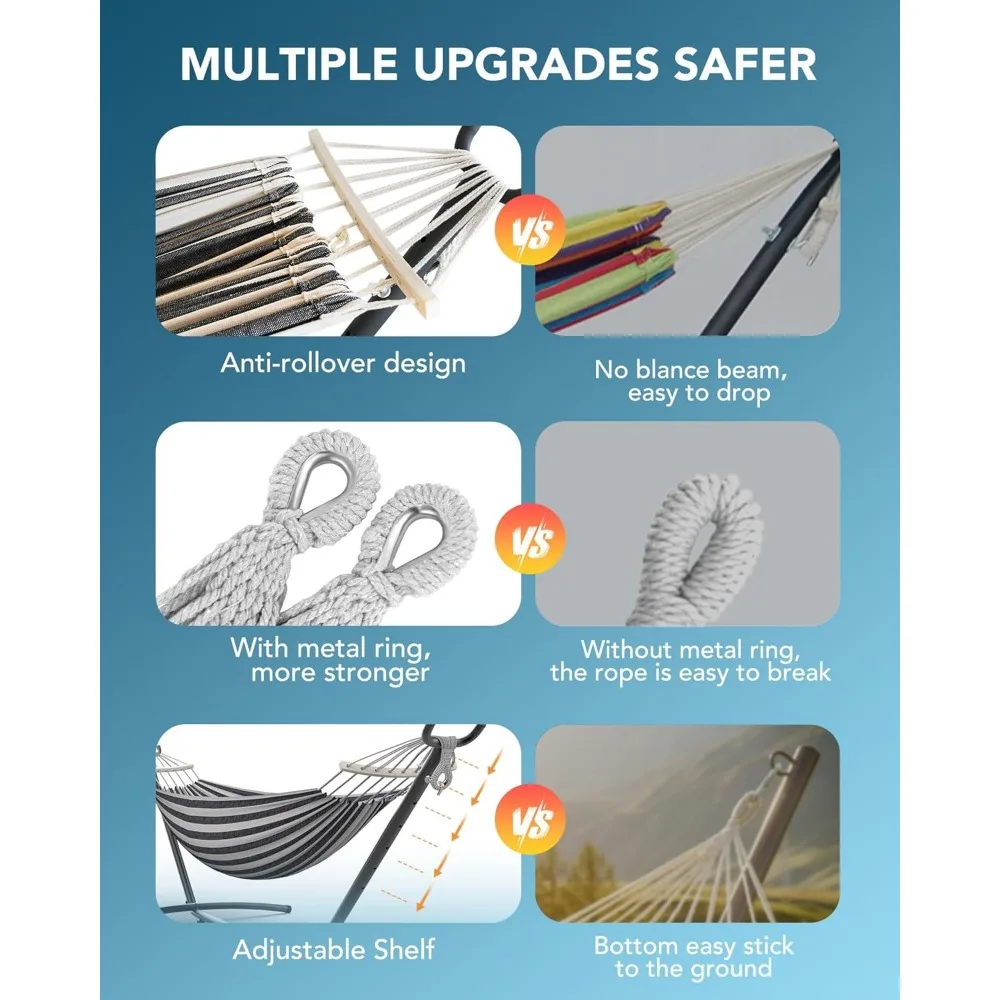
Hammock stands introduce another variable in weight capacity calculations. A stand’s design, material, and construction quality determine its safe load limit. Key factors include:
– Tubing diameter and wall thickness
– Connection point design and reinforcement
– Base stability and weight distribution
– Cross-bracing and support structures
Camping Hammock Sets with Bug Net, Ultralight Camping Hammock Sets
$139.72 Select options This product has multiple variants. The options may be chosen on the product pageClassic Wooden Stand Hammock Sets, Heavy Duty Hammock Sets
$1,061.68 Select options This product has multiple variants. The options may be chosen on the product pageHammock Sets with Canopy, Heavy Duty Hammock Sets
$286.31 Select options This product has multiple variants. The options may be chosen on the product pageDouble / Two Person Hammock Sets, Rope Hammock Sets
Double Traditional Cotton Rope Hammock with Extension Chains – 450 lbs Capacity for Backyard & Patio$292.98 Select options This product has multiple variants. The options may be chosen on the product pageFolding Hammock Sets, Quick Setup Hammock Sets
Price range: $305.52 through $583.27 Select options This product has multiple variants. The options may be chosen on the product pageHeavy Duty Hammock Sets, Wooden Arc Stand Hammock Sets
$878.66 Select options This product has multiple variants. The options may be chosen on the product page
Making Smart Choices: Selecting the Right Weight Capacity
When selecting a hammock based on weight capacity, follow these practical guidelines:
Calculate your total load requirements:
– User weight (or combined users for double hammocks)
– Additional gear (backpacks, blankets, etc.)
– Add 25-30% safety margin to account for movement and aging
Evaluate quality indicators:
– Triple or reinforced stitching at stress points
– Heavy-duty hardware with visible ratings
– Wide, even seams without puckering
– Robust attachment points with reinforcement
– Consistent weave pattern without thin spots
Consider your usage pattern:
– Occasional use can work with standard capacities
– Daily use benefits from higher capacity ratings
– Adventure activities require greater safety margins
– Multiple users need substantially higher ratings
For those requiring specialized support, the ultimate guide hammocks heavier individuals provides tailored recommendations that focus on both capacity and comfort.
Remember that manufacturer ratings represent ideal conditions. Environmental factors like wet weather, extreme temperatures, and UV exposure can temporarily or permanently reduce actual capacity.
Maintaining Safe Weight Capacity Over Time
A hammock’s weight capacity isn’t permanent—it changes throughout the product’s life:
Factors that reduce capacity over time:
– UV exposure breaks down synthetic fibers (up to 10-15% strength loss annually in direct sun)
– Moisture exposure weakens natural fibers and can promote mildew
– Physical stretching from repeated use loosens weave patterns
– Hardware wear creates potential failure points
– Environmental contaminants (salt water, chlorine, oils) degrade materials
Maintenance practices to preserve capacity:
– Store indoors when not in use
– Clean according to material-specific instructions (avoid harsh chemicals)
– Inspect regularly for wear signs:
– Faded or discolored areas
– Visible fraying or loose threads
– Stretched or deformed fabric
– Rust or corrosion on metal components
– Replace suspension components showing wear before they fail
With proper care, quality hammocks can maintain near-original weight capacities for 5-10 years depending on usage frequency and conditions.
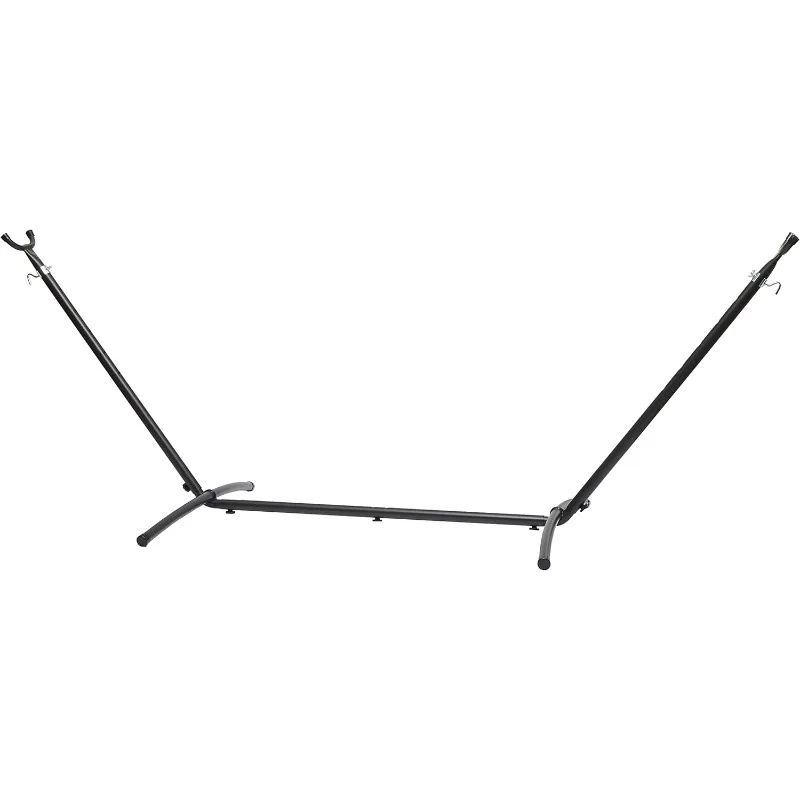
For multiple users, freestanding hammocks couples features comfort offers specific insights into maintaining appropriate support for shared relaxation.
FAQ: Common Questions About Hammock Weight Limits
Is it safe to approach the maximum weight limit?
Yes, quality hammocks are designed with safety factors built in. However, staying 15-20% below the maximum rating provides a comfortable buffer for unexpected movements or gradual wear.
What happens if I slightly exceed the stated limit?
Occasionally exceeding the limit by a small amount (5-10%) may not cause immediate failure but accelerates wear. Consistent overloading will significantly shorten the hammock’s lifespan and increase failure risk.
Do weather conditions affect weight capacity?
Absolutely. Wet fabric can lose 10-20% of its strength temporarily. Extreme cold can make materials brittle, while UV exposure permanently weakens fibers over time.
Can I increase my hammock’s weight capacity?
You can’t meaningfully increase a hammock’s inherent capacity, but you can ensure you’re maximizing available strength by:
– Using wider tree straps to distribute pressure
– Maintaining proper hanging angles (30-45°)
– Adding a structural ridgeline to control sag
– Ensuring anchor points exceed hammock capacity
How accurate are manufacturer weight ratings?
Ratings vary in reliability between manufacturers. Established brands with good reputations typically provide conservative, reliable ratings. Budget options might use theoretical maximum capacity without adequate safety margins.
For specialized lightweight options with precisely calculated capacities, consider ultralight camping hammock sets designed with careful attention to weight-to-strength ratios.
When to Prioritize Higher Weight Capacity: Special Considerations
Certain situations warrant investing in hammocks with significantly higher weight capacities:
Scenarios requiring enhanced capacity:
– Shared use by couples or families
– Users approaching standard weight limits
– Active lounging with movement or swinging
– Installation in public or commercial spaces
– Long-term permanent setups
Higher capacity models from Outside Luxe feature valuable design elements worth the investment:
– Multi-layer fabric construction
– Military-grade suspension components
– Reinforced edge channels and stress points
– Heavy-duty stands with structural cross-bracing
For portable options that don’t sacrifice strength, folding hammock sets offer convenience alongside carefully engineered support systems.
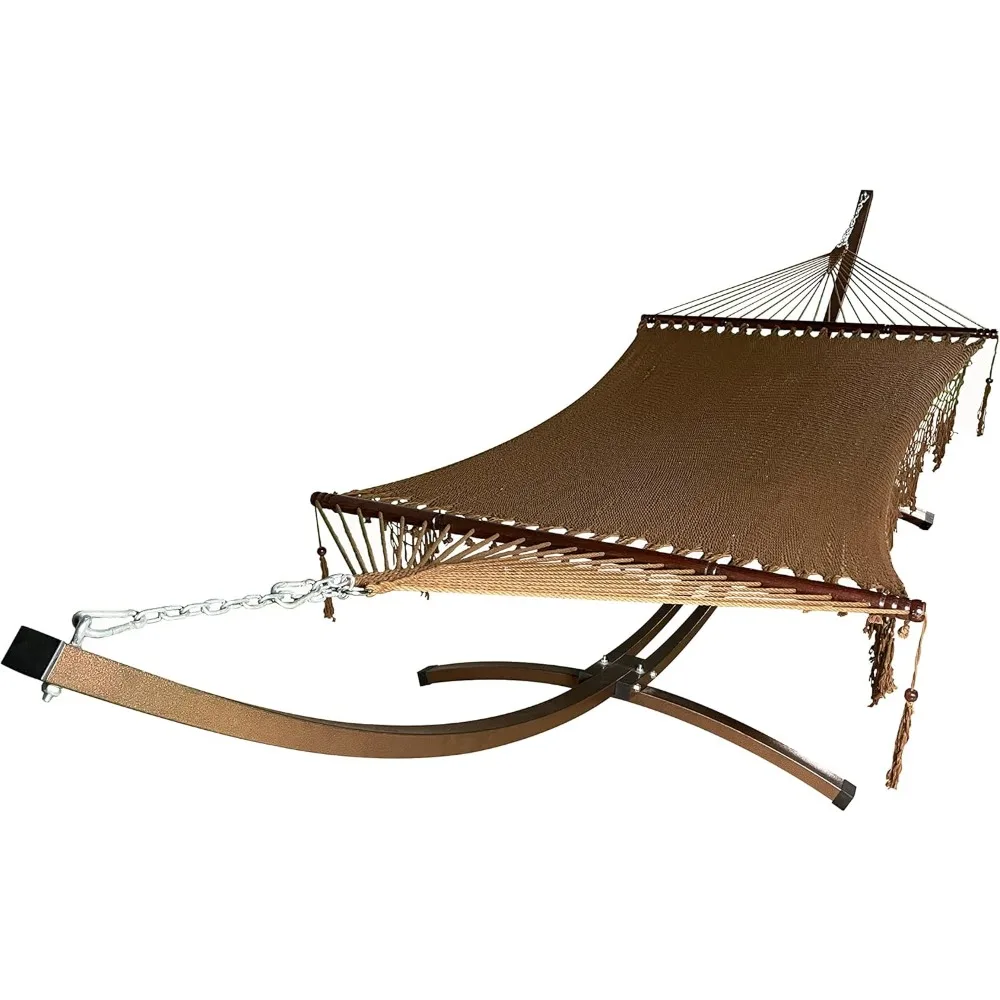
Remember that proper weight capacity isn’t just about preventing catastrophic failure—it’s about ensuring years of safe, comfortable enjoyment. By understanding the engineering principles behind hammock design, you can make informed choices that provide both peace of mind and the perfect relaxation experience.

